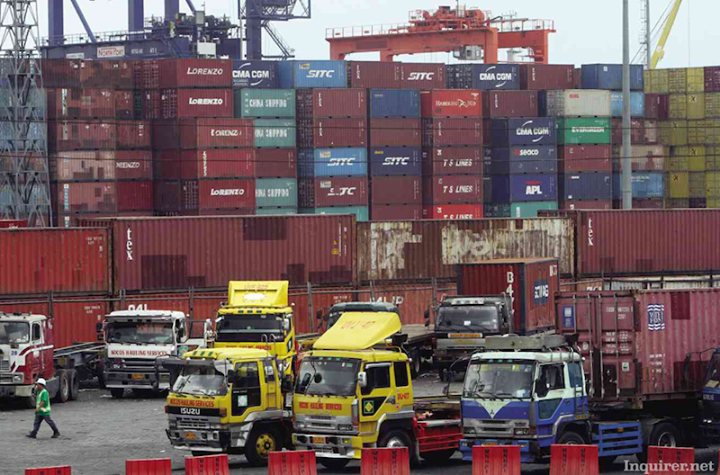Transcript of Sen. Bam Aquino’s Interview after the 2nd Port Congestion Hearing
Iyong problema natin sa port congestion, physically, medyo gumaganda na. Iyong paglabas ng mga containers tumataas na. In fact, mas mataas na siya bago nagkaroon ng truck ban.
Pero iyong charges, naroon pa rin. Iyong increased charges na iyan ang nagdudulot ng pagtaas ng presyo ng bilihin.
We really have to look at the charges that are being imposed on the different stakeholders.
Iyong isang pinanggagalingan ng charges, mula sa shipping lines, we need to see kung justifiable ba talaga ang charges na iyon o hindi.
Mayroong mga charges na opisyal at mayroon ding unofficial o iyong tinatawag nating under the table. Iyon din, kailangang matigil din para mabalik natin ang sitwasyon iyong bago ang truck ban at ma-prevent natin ang pagtaas ng presyo ng bilihin.
Q: Iimbitahan ba ang shipping lines sa next hearing?
A: Yes. Ganito kasi iyan, iyong truckers pag dinadala iyong container, dinadala iyan to a specific container yard. At iyong partnership na iyon ay between the container yard at shipping line.
So walang rason, pagdating ng trucker doon sa container yard, sasabihan siya wala nang space. Ibig sabihin doon, hindi nagkaroon ng pagkakaunawaan ang container yard at shipping line.
Ang trucker naman, pinaalis siya walang space, dumadami ang oras na naha-hire siya, tumataas ang sinisingil niya sa importer. Ang importer naman i-cha-charge iyon sa taumbayan.
Kaninong responsibilidad na mayroong container yard, siyempre sa mga shipping lines iyon.
Ang masakit diyan, iyong shipping lines natin, kapag late binalik ang container, icha-charge ka pa rin.
In short, some of these charges need to be investigated. DTI has volunteered na tipunin ang mga shipping lines. I-analyze ang mga charges na ito at tingnan kung ano ba ang justifiable at iyon ba ang mamimihasa na lang. Nag-iba na ang sitwasyon at kailangan nang ibalik iyon sa dati.
Q: Mas gusto pa nga nilang nade-delay, dahil higher ang charges ng shipping lines.
A: Hindi lang shipping lines.
Marami pong mga elemento, na may gusto nilang may delay, gusto nila may inefficiency at gusto nilang may congestion kasi nakakapag-charge sila, nakakahingi sila under the table, ang talo diyan ang taumbayan.
Kaya dapat isa-isahin natin ito at tingnan natin ang mga charges na unjustifiable na. Ano ba ang mga proseso na nakakadagdag sa problema, legal processes.
We talked to Customs and BIR today, baka may proseso sila na dapat bawasan na and of course, i-curb natin ang corruption.
Sabi nila noon daw, may pang-tip sila, tagbe-bente pesos, iyong mga ganun daw libu-libo na daw ngayon.
We have to stop that and we can only stop that one is meron tayong monitoring, two mayroon tayong enforcement may nakukulong dahil sa bribes na iyan. At hindi lang siya sa government dahil sa private sector may pangyayari ding ganyan.
Pangatlo, we really need to push for technology dahil ito ang nakikitang solusyon dito. Kung mayroon tayong ticketing system o tracking system, hindi na magkakaroon na nagta-trapik sila, nagsasabay-sabay, nakapila sa port na wala namang negosyong makukuha.
If we have that technology, which these days din a ganun kahirap iyon, and they were following the system, it will help our truckers in terms of their efficiency and at the same time, puwede pang bumaba ang kanilang sinisingil dahil mas efficient sila.
Q: Do you agree to the proposal na no-human contact, no-paper policy?
A: Ganoon po talaga dapat. As soon as possible dapat. In fairness, kumuanti na nang kumaunti iyon through the years. Ngayon, talagang less and less na ang nakikita mo.
Pero siguro if we can implement that, not just for port operations, but for BIR and Customs, it will help solve corruption.
Q: May ilang foreign business groups na nagsabing they will stop business sa Pilipinas kapag di na-solve ang port congestion.
A: Kung mayroon silang mga issue, temporary lang iyan. Kung tutuusin, iyong ekonomiya natin ngayon, we’re the best economy in the ASEAN.
Mahihirapan sila na hindi i-access ang market natin. Maybe pansamantala, they’re having some issues but as fast as we solve this problem, they will be back because this is a huge market.
They need the Philippines to do business well.
Q: So hindi dapat balewalain ang threat na iyon?
A: Siyempre hindi. Lahat ng negosyo dito iyong ang hinihikayat natin. We want more foreign investments in the Philippines, we want more trade to happen. That’s why patuloy itong mga hearing at patuloy ang pagresolba ng isyung ito.
Q: Do you think we can manage the influx of goods this Christmas season?
A: Since we started this hearing, marami nang improvements. Each step na may bagong improvement, may bago ring na-uncover na problema.
Palagay ko, ang kinakailangan naming gawin, bilang Committee on Trade, is to make sure na ang solusyon natin all the way.
Hindi puwedeng halfway lang. Pakakawalan natin and in a year’s time, ito na naman ang problema.
We have to go all the way.
If you notice na sa hearing natin, we went from short term to medium term to long term. The best way to resolve these issues, gawin natin ang short term sa mabilis na panahon pero huwag pakawalan ang medium at long term solutions kasi iyon ang magdidikta kung mangyayari pa ito uli o we can really move forward and improve our port situation and our economy and make sure na hindi magtaasan ang presyo ng produkto.


Recent Comments